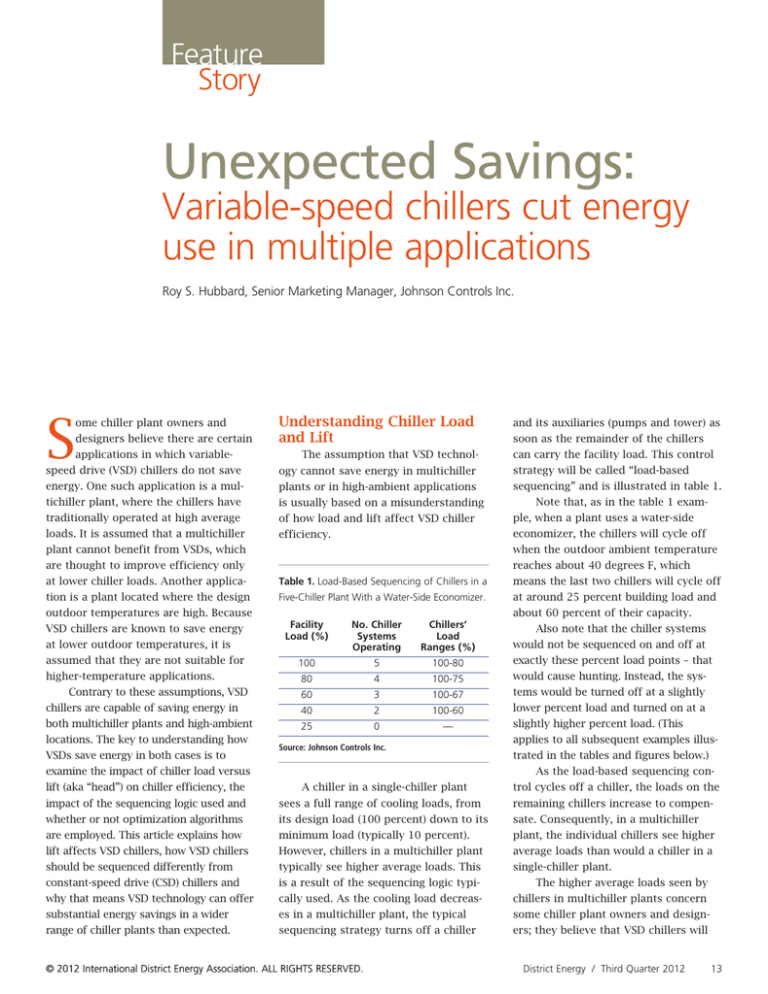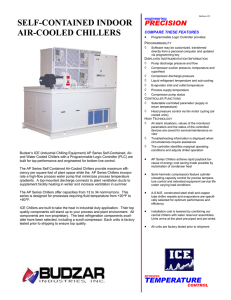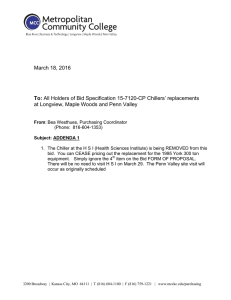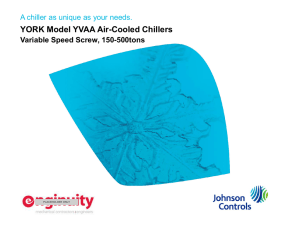
Feature
Story
Unexpected Savings:
Variable-speed chillers cut energy
use in multiple applications
Roy S. Hubbard, Senior Marketing Manager, Johnson Controls Inc.
S
ome chiller plant owners and
designers believe there are certain
applications in which variablespeed drive (VSD) chillers do not save
energy. One such application is a multichiller plant, where the chillers have
traditionally operated at high average
loads. It is assumed that a multichiller
plant cannot benefit from VSDs, which
are thought to improve efficiency only
at lower chiller loads. Another application is a plant located where the design
outdoor temperatures are high. Because
VSD chillers are known to save energy
at lower outdoor temperatures, it is
assumed that they are not suitable for
higher-temperature applications.
Contrary to these assumptions, VSD
chillers are capable of saving energy in
both multichiller plants and high-ambient
locations. The key to understanding how
VSDs save energy in both cases is to
examine the impact of chiller load versus
lift (aka “head”) on chiller efficiency, the
impact of the sequencing logic used and
whether or not optimization algorithms
are employed. This article explains how
lift affects VSD chillers, how VSD chillers
should be sequenced differently from
constant-speed drive (CSD) chillers and
why that means VSD technology can offer
substantial energy savings in a wider
range of chiller plants than expected.
Understanding Chiller Load
and Lift
The assumption that VSD technology cannot save energy in multichiller
plants or in high-ambient applications
is usually based on a misunderstanding
of how load and lift affect VSD chiller
efficiency.
Table 1. Load-Based Sequencing of Chillers in a
Five-Chiller Plant With a Water-Side Economizer.
Facility Load (%) No. Chiller
Systems Operating
Chillers’
Load
Ranges (%)
100
5
100-80
80
4
100-75
60
3
100-67
40
2
100-60
25
0
—
Source: Johnson Controls Inc.
A chiller in a single-chiller plant
sees a full range of cooling loads, from
its design load (100 percent) down to its
minimum load (typically 10 percent).
However, chillers in a multichiller plant
typically see higher average loads. This
is a result of the sequencing logic typically used. As the cooling load decreases in a multichiller plant, the typical
sequencing strategy turns off a chiller
© 2012 International District Energy Association. ALL RIGHTS RESERVED.
and its auxiliaries (pumps and tower) as
soon as the remainder of the chillers
can carry the facility load. This control
strategy will be called “load-based
sequencing” and is illustrated in table 1.
Note that, as in the table 1 example, when a plant uses a water-side
economizer, the chillers will cycle off
when the outdoor ambient temperature
reaches about 40 degrees F, which
means the last two chillers will cycle off
at around 25 percent building load and
about 60 percent of their capacity.
Also note that the chiller systems
would not be sequenced on and off at
exactly these percent load points – that
would cause hunting. Instead, the systems would be turned off at a slightly
lower percent load and turned on at a
slightly higher percent load. (This
applies to all subsequent examples illustrated in the tables and figures below.)
As the load-based sequencing control cycles off a chiller, the loads on the
remaining chillers increase to compensate. Consequently, in a multichiller
plant, the individual chillers see higher
average loads than would a chiller in a
single-chiller plant.
The higher average loads seen by
chillers in multichiller plants concern
some chiller plant owners and designers; they believe that VSD chillers will
District Energy / Third Quarter 2012
13
not save energy in this application.
However, they are neglecting to account
for changes in lift.
“Lift” is defined as the pressure differential against which the compressor
operates. In a water chiller, the lower
pressure is driven by the refrigerant
evaporating temperature, which is determined primarily by the leaving chilledwater temperature. The higher pressure
is determined by the refrigerant condensing temperature, which is primarily
a function of the weather conditions.
Specifically, it is driven by the dry-bulb
temperature of the air entering an aircooled chiller or the wet-bulb temperature of the air entering the cooling
tower, which in turn determines the
entering condenser water temperature
(ECWT) for a water-cooled chiller.
Here is a key point: The cooling
towers all experience the same weather,
and therefore they supply water at the
same instantaneous ECWT to the chillers in the plant, regardless of the load.
To analyze the impact on energy
performance caused by changes in load
and lift, figure 1 will be used. It shows
energy performance curves that are
“industry average,” reflecting averages
of published curves for multiple brands
of water-cooled VSD centrifugal chillers.
How do load changes impact energy
consumption of a VSD chiller? In figure 2,
the lift is held constant at 85 F ECWT, and
the load is allowed to vary. The result is
that the kilowatts per ton of cooling vary
relatively little – only about 15 percent.
On the other hand, how do lift
changes impact energy consumption? In
figure 3, the load is held constant at
100 percent, and the lift is allowed to
vary. The variation in chiller efficiency
is around 45 percent. Compared to the
15 percent impact of variable load, that
is a 3-1 ratio! This demonstrates that
lift has a major impact on chiller efficiency, while load has a much lower
impact. Therefore, VSDs can save energy
in multichiller plants, even though the
average chiller loads are higher. One key
to saving energy with VSD chillers is the
lift variation.
One key to saving energy with
VSD chillers is the lift variation.
Performance in Multichiller
Plants
The influence of load and lift on
VSD and CSD chillers was examined by
this author in an analysis of a hypothetical large U.S. district cooling plant.
The plant was assumed to contain
five 2,250-ton (7.9 MW) water-cooled
centrifugal chillers, each with dedicated
auxiliaries: chilled-water pump, condenser water pump and cooling tower.
A typical load line was assumed, as was
24/7 operation. A water-side economizer was also assumed.
The choice of weather data used
in this analysis required a compromise.
Rather than drawing on data from any
one particular location, the concept
of “average U.S. weather data” was
employed to make the analysis as widely applicable as possible. This is the
same weather data used by the AirConditioning, Heating, and Refrigeration
Institute (AHRI) to calculate the IPLV/
NPLV (integrated part-load value/nonstandard part-load valve) ratings for
chillers in AHRI Standard 550/590-98.
The data was created by looking at
weather data in the 29 cities across the
United States that correlated with 80 percent of all the centrifugal chiller sales
over a 25-year period. The data for the
29 cities were then averaged. The concept of average U.S. weather data has
been approved by the major chiller
manufacturers as an acceptable compromise for use in analyzing chiller
energy consumption.
Only chiller energy consumption
was examined in the study as well as
for this article. Inclusion of the auxiliaries (cooling towers and pumps) would
have required a large number of variables, such as how they are driven (CSD
or VSD), the piping scheme (headered or
dedicated pumping, primary-secondary
or variable primary, etc.) and the operating method used (manual, automated or
Figure 1. Performance of an “Industry Average” Water-Cooled
Figure 2. Efficiency Changes With Variable Load on a VSD Centrifugal
VSD Centrifugal Chiller.
Chiller.
.80
Kilowatts per ton of cooling
.60
.50
.40
.30
n
n
n
n
.20
.10
85 F ECWT
75 F ECWT
65 F ECWT
55 F ECWT
| |||||| ||
.00 20% 30%40%50%60%70%80% 90%100%
Load
Source: Johnson Controls Inc.
District Energy / Third Quarter 2012
.70
.60
Kilowatts per ton of cooling
.70
14
.80
Design performance
100% Load
85 F ECWT
0.600kW/ton
15%
.50
.40
.30
.20
.10
n
n
n
n
85 F ECWT
75 F ECWT
65 F ECWT
55 F ECWT
| |||||| ||
.00 20% 30%40%50%60%70%80% 90%100%
Load
Source: Johnson Controls Inc.
© 2012 International District Energy Association. ALL RIGHTS RESERVED.
optimized). Since the intent of this article is to examine the impact of adding
VSDs to the chillers, the impact of the
auxiliaries has not been calculated.
Drawing on data from the analysis,
the following scenarios demonstrate the
performance of CSD and VSD chillers
using different sequencing methods:
Scenario 1: CSD Chillers With
Traditional Load-Based Sequencing
In scenario 1, the chillers were all
CSD and used the performance curves
in figure 4, which are averages of published curves for multiple brands of
water-cooled CSD centrifugal chillers.
The load-based sequencing strategy was
also used.
The tool/method used to do the
energy analysis was the ASHRAE modified temperature bin method (Simplified
Energy Analysis Using the Modified Bin
Method, ASHRAE, David E. Knebel, principal investigator, 1983).
Table 2 shows how the five chillers
unload when controlled by the traditional
load-based sequencing control strategy,
heretofore considered the most efficient
method of sequencing a plant. The red
rectangles show the chillers cycling off,
while the green rectangles show the loads
on the remaining on-line chillers increasing to pick up the remaining building
load. The water-side economizer enabled
the chillers to be completely cycled off
when the outdoor air was below 40 F.
Table 3 shows how the efficiency
values from figure 4, the loads from
table 2 and the weather data were used
to calculate the annual energy consumption for CSD chiller No. 1. It is important
to note that the 95.0-99.0 F temperature
bin does not represent design conditions
only. It is an average of the few hours
spent at design conditions plus a number of hours spent at off-design conditions. That is why the load and efficiency
values are lower than at design.
The annual energy consumption for
CSD chiller No. 1 was 5,972,580 kWh.
The same calculation process was used
for CSD chillers Nos. 2-5 (not shown
because of limited space). The total
annual energy consumption for all five
chillers was 18.35 million kWh.
Scenario 2: VSD Chillers With
Traditional Load-Based Sequencing
In scenario 2, all the chillers were
equipped with VSDs, and the energy performance curves in figure 1 were used.
Built into figure 1 is a 3 percent loss for
the VSDs. The load-based sequencing
strategy was used again. The total annual
energy consumption for all five VSD
chillers was 15.4 million kWh, a savings
of 16 percent.
Scenario 3: VSD Chillers With EnergyBased Sequencing
In scenario 3, the chillers were
again equipped with VSDs, but the
Figure 3. Efficiency Changes With Variable Lift on a VSD Centrifugal Chiller.
sequencing strategy was modified.
Because VSDs offer the most energy
savings at lower loads and lower
ECWTs, it makes sense to keep them on
line for as long as possible while the
cooling load of the facility decreases.
Therefore, a chiller system was not
turned off until the energy consumption
of operating all the on-line chillers
exceeded the energy consumption of
operating all the on-line chillers minus
one. This control strategy – which is
really an optimization algorithm – will
be called “energy-based sequencing™.”
Table 4 shows how the five chillers
unload when optimized by the energybased sequencing strategy. Once again,
the red rectangles show the chillers
cycling off, while the green rectangles
show the loads on the remaining on-line
chillers increasing to pick up the remaining building load.
The sequencing points are significantly different from the points used
with the load-based sequencing strategy. For instance, the most cost-efficient
point at which the first chiller system
should be turned off was when the facility load had fallen to about 33 percent.
The sequencing points are not linear;
they are determined by the energy consumption and not just the load. Note
also that the chiller loads, indicated by
the green rectangles, are lower than
when load-based sequencing strategy is
used. Determining the sequencing
Figure 4. Performance of an “Industry Average” Water-Cooled CSD
Centrifugal Chiller.
.80
.80
.70
.70
.60
45%
.50
.40
.30
.20
.10
n
n
n
n
85 F ECWT
75 F ECWT
65 F ECWT
55 F ECWT
| |||||| ||
.00 20% 30%40%50%60%70%80% 90%100%
Load
Source: Johnson Controls Inc.
© 2012 International District Energy Association. ALL RIGHTS RESERVED.
Kilowatts per ton of cooling
Kilowatts per ton of cooling
.60
Design performance
100% Load
85 F ECWT
0.582 kW/ton
.50
.40
.30
.20
.10
n
n
n
n
85 F ECWT
75 F ECWT
65 F ECWT
55 F ECWT
| |||||| ||
.00 20% 30%40%50%60%70%80% 90%100%
Load
Source: Johnson Controls Inc.
District Energy / Third Quarter 2012
15
Table 2. Chiller Loading When Using Load-Based Sequencing.
Temperature Building
Bin (°F)
Load
(Tons)
Building
Load (%)
Chiller
Chiller Capacities (Tons)
Capacity
No. 1 No. 2 No. 3 No. 4 No. 5
(%)
95.0-99.9 10,810
96.1
96.1
2,1622,1622,1622,1622,162
90.0-94.9
9,935
88.3
88.3
1,9871,9871,9871,9871,987
85.0-89.9
9,060
80.5
80.5
1,8121,8121,8121,8121,812
80.0-84.9
8,180
72.7
90.9
2,0452,0452,0452,045
0
75.0-79.9
7,304
64.9
81.2
1,8261,8261,8261,826
0
70.0-74.9
6,426
57.1
95.2
2,1422,1422,142
00
65.0-69.9
5,550
49.3
82.2
1,8501,8501,850
0
0
60.0-64.9
4,674
41.5
69.2
1,5581,5581,558
0
0
55.0-59.9
3,800
33.7
84.4
1,9001,900
0 00
50.0-54.93,272 29.1 72.61,636
1,636 0 00
45.0-49.93,066 27.2 68.11,533
1,533 0 00
40.0-44.92,858 25.4 63.61,429
1,429 0 00
Table 3. Annual Energy Consumption for CSD Chiller No. 1 With Traditional Load-Based Sequencing.
Temp. Average
Tower
Entering
Load Efficiency Draw Hours Energy
Bin (°F) Wet-Bulb Approach Condenser (Tons) (kW/Ton) (kW) (kWh) Usage
Temp. (°F)
(ºF)
Water
Temp. (°F)
points when using energy-based
sequencing requires a central plant
optimization (CPO) system, which can
analyze the multitude of variables that
impact the decision beyond just load.
The total annual energy consumption for all five VSD chillers, controlled
by energy-based sequencing, was
12.87 million kWh. That is a savings
of 30 percent. By controlling the VSD
chillers with energy-based sequencing
using a CPO system, the savings was
increased an additional 14 percent.
This analysis shows that VSDs can
significantly reduce chiller energy consumption in multichiller plants. Even
if the average chiller load is high, as
when using the load-based sequencing,
the chiller lift decreases, and lift has a
bigger impact on chiller efficiency than
does load.
95.0-99.9 72.0
7.9
79.9
2,1620.5601,212 37 44,844
Energy-based sequencing is
90.0-94.9 71.0
7.6
78.6
1,9870.5441,081120129,671
85.0-89.9
7.4
76.4
1,812
another key to maximizing
80.0-84.9 68.0
8.4
76.4
2,0450.5331,089515561,075
75.0-79.9
8.0
74.0
1,826
70.0-74.9 63.0
9.8
72.8
2,1420.5141,101928
1,021,684
65.0-69.9
59.0
9.6
68.6
1,850
0.484
895
895
801,228
60.0-64.9
55.0
9.2
64.2
1,558
0.458
713
856
610,421
55.0-59.9
50.0
12.0
62.0
1,898
0.447
848
776
658,062
50.0-54.9
45.0
11.9
56.9
1,635
0.411
672
679
456,483
45.0-49.9
41.0
14.0
55.0
1,533
0.397
608
586
356,535
40.0-44.9
37.0
18.0
55.0
1,430
0.397
568
549
311,903
69.0
66.0
0.526
0.514
953
938
303
780
288,897
731,777
Subtotal
5,972,580
Table 4. Chiller Loading When Using Energy-Based Sequencing.
Temperature Building
Bin (°F)
Load
(Tons)
Building
Load (%)
Chiller
Chiller Capacities (Tons)
Capacity
No. 1 No. 2 No. 3 No. 4 No. 5
(%)
95.0-99.9
10,81096.196.1
2,162
2,162
2,162
2,162
2,162
90.0-94.9
9,93588.388.3
1,987
1,987
1,987
1,987
1,987
85.0-89.9
9,06080.580.5
1,812
1,812
1,812
1,812
1,812
80.0-84.9
8,18072.772.7
1,636
1,636
1,636
1,636
1,636
75.0-79.9
7,30564.964.9
1,461
1,461
1,461
1,461
1,461
70.0-74.9
6,42557.157.1
1,286
1,285
1,285
1,285
1,285
65.0-69.9
5,55049.349.3
1,110
1,110
1,110
1,110
1,110
60.0-64.9
4,67541.541.5 935
935
935
935
935
55.0-59.9
3,80033.833.8 760
760
760
760
760
50.0-54.9
3,272
29.1
36.4
45.0-49.9
3,066
27.3
45.4
818 818 818818 0
1,0221,022 1,022
00
40.0-44.9
2,85925.442.4 953
953
9530
0
Tables 2, 3 and 4 source: Johnson Controls Inc.
16
District Energy / Third
FourthQuarter
Quarter2012
2011
savings in VSD chiller plants.
Resequencing VSD chillers based
on energy means they will run in their
sweet spot – or sweet span – as much
as possible, which often means lower
loads. Energy-based sequencing is
another key to maximizing savings in
VSD chiller plants. This strategy leverages the savings capabilities of VSDs
at lower loads and, most importantly,
lower ECWTs. The auxiliaries can marginally add to or subtract from these
savings, depending on the piping configuration and control.
Although this analysis was done
on a large chiller plant, the percentages of savings are scalable to any
size plant; and, because industry
average efficiency curves were used,
the analysis is valid for any brand of
VSD chiller.
The cost-effectiveness of adding
VSDs to the chillers will depend on a
number of factors, including the capital and installation costs of the VSDs,
local electricity cost and cooling load
profile. These factors are highly individual and outside the scope of this
article.
© 2012 International District Energy Association. ALL RIGHTS RESERVED.
Performance in HighAmbient Locations
Are VSD chillers a good investment
in locations that experience high outdoor temperatures, such as the Middle
East? The answer is, “Often.” Once
again, it depends on the weather. The
design dry-bulb and wet-bulb temperatures are not the critical factors. Most
important is whether there is a significant variation in the temperatures
throughout the cooling season.
Dhahran, Saudi Arabia, has design
temperatures of 110 F dry bulb and 86
F wet bulb, making it one of the warmest and most humid cities in the world.
However, the outdoor temperatures can
also fall to 35 F dry bulb and 32 F wet
bulb. This substantial change in outdoor
temperatures indicates VSDs are likely
to provide significant energy savings.
The same 11,250-ton (39.5 MW)
plant analyzed above was relocated to
Dhahran, with the efficiency of the chillers adjusted for the higher lift. The total
annual energy consumption for all five
CSD chillers, controlled with load-based
sequencing, was 32.08 million kWh.
When the chillers were equipped
with VSDs, and operated with CPOdriven energy-based sequencing, the
total annual energy consumption was
23.31 million kWh – an energy savings
of 27 percent.
So, even in high-ambient locations,
putting VSDs on the chillers and using
an energy-based sequencing strategy
reduced plant energy consumption significantly. The key is that the location has
temperatures that vary throughout the
day and the cooling season; the design
temperatures are rarely applicable.
Conclusion
Water-cooled VSD chillers are capable of saving energy in both multichiller
plants and high-ambient locations. If the
leaving chilled-water temperature and
condenser water flow are constant, the
key to their performance is the variation
in entering condenser water temperature,
which lowers the chiller lift. Additional
energy savings can be obtained by
sequencing the chillers according to an
energy-based sequencing strategy,
designed to get the maximum performance from the VSDs. Energy-based
sequencing requires a central plant optimization system, which can analyze the
multitude of variables that impact the
decision beyond just load. As a result,
chiller plant owners and designers will
find VSD chillers yield substantial energy
savings in a surprisingly wide range of
chiller plants.
Roy S. Hubbard is senior marketing
manager with Johnson Controls Inc.,
a global provider of HVAC
equipment, controls and service
solutions. He has more than 30 years
of experience in sales, marketing and
applications, with particular focus on
chilled-water systems. He is also the architect for
YORKcalc, Johnson Controls’ operating cost software
for chiller plants. Hubbard holds a bachelor’s degree in
engineering from the U.S. Military Academy at West
Point. He can be reached at roy.s.hubbard@jci.com.
The Water Treatment Choice of Over 100 Colleges & Universities
Chem-Aqua, Inc. • 1-800-527-9921 • www.chemaqua.com
Irving, TX • Monmouth, NJ • Jacksonville, FL • Indianapolis, IN • Macon, GA • Las Vegas, NV • Sunnyvale, CA • Brampton, ON
IDEA_DistrictEnergy_Q3_2012.indd
1
© 2012
International District Energy
Association. ALL RIGHTS RESERVED.
7/5/2012
10:42:06 AM
District Energy / Third Quarter
2012
17





